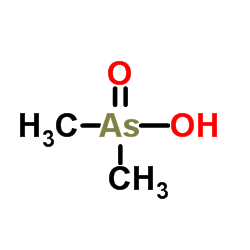Cacodylic acid

Cacodylic acid structure
|
Common Name | Cacodylic acid | ||
|---|---|---|---|---|
| CAS Number | 75-60-5 | Molecular Weight | 137.997 | |
| Density | >1.1(20ºC) | Boiling Point | 253.1±23.0 °C at 760 mmHg | |
| Molecular Formula | C2H7AsO2 | Melting Point | 195-198 °C | |
| MSDS | Chinese USA | Flash Point | 109.4±17.3 °C | |
| Symbol |



GHS06, GHS08, GHS09 |
Signal Word | Danger | |
|
Effect of Dextran 70 on the thermodynamic and structural properties of proteins.
Int. J. Biol. Macromol. 79 , 86-94, (2015) Biological macromolecules are known to evolve and function under crowded intracellular environments that comprises of a wealth of soluble and insoluble macromolecules like proteins, nucleic acids, ribosomes and carbohydrates etc. Crowded environment is known ... |
|
|
Generalized model of electromigration with 1:1 (analyte:selector) complexation stoichiometry: part II. Application to dual systems and experimental verification.
J. Chromatogr. A. 1384 , 147-54, (2015) Interactions among analyte forms that undergo simultaneous dissociation/protonation and complexation with multiple selectors take the shape of a highly interconnected multi-equilibrium scheme. This makes it difficult to express the effective mobility of the a... |
|
|
Arsenic(+3) and DNA methyltransferases, and arsenic speciation in tadpole and frog life stages of western clawed frogs (Silurana tropicalis) exposed to arsenate.
Metallomics 7 , 1274-84, (2015) Western clawed frog (Silurana tropicalis) embryos were exposed to control, low (nominally 0.5 mg L(-1)) and high (nominally 1 mg L(-1)) arsenate (As(V)) culture water concentrations to investigate the effects of arsenic (As) on different life stages, namely t... |
|
|
Divergent cell cycle kinetics of midgestation ventricular cells entail a higher engraftment efficiency after cell transplantation.
Am. J. Physiol. Cell Physiol. 308(3) , C220-8, (2015) Cardiac progenitor cells (CPCs) in the primary and secondary heart fields contribute to the formation of all major cell types in the mammalian heart. While some CPCs remain undifferentiated in midgestation and postnatal hearts, very little is known about thei... |
|
|
Structure analysis of free and bound states of an RNA aptamer against ribosomal protein S8 from Bacillus anthracis.
Nucleic Acids Res. 42(16) , 10795-808, (2014) Several protein-targeted RNA aptamers have been identified for a variety of applications and although the affinities of numerous protein-aptamer complexes have been determined, the structural details of these complexes have not been widely explored. We examin... |
|
|
Methods of high integrity RNA extraction from cell/agarose construct.
BMC Res. Notes 8 , 644, (2015) Agarose hydrogels are widely used for three-dimensional cell scaffolding in tissue engineering and cell biology. Recently, molecular profiles have been obtained with extraction of a minimal volume of RNA using fluorescent-tagged quantitative polymerase chain ... |
|
|
Histone demethylase Utx regulates differentiation and mineralization in osteoblasts.
J. Cell. Biochem. 116 , 2628-36, (2015) Alteration of methylation status of lysine 27 on histone H3 (H3K27) associates with dramatic changes in gene expression in response to various differentiation signals. Demethylation of H3K27 is controlled by specific histone demethylases including ubiquitousl... |
|
|
Antimony, Arsenic and Chromium Speciation Studies in Biała Przemsza River (Upper Silesia, Poland) Water by HPLC-ICP-MS.
Int. J. Environ. Res. Public Health 12 , 4739-57, (2015) In this paper the total concentration of As, Cr, Sb, pH and the red-ox potential of water and sediment samples of the Biała Przemsza River were determined. The arsenic (AB, MMA, DMA, As(III), As(V)), chromium (Cr(III), Cr(VI)) and antimony (Sb(III), Sb(V)) fo... |
|
|
Enzyme-assisted extraction and liquid chromatography mass spectrometry for the determination of arsenic species in chicken meat.
Anal. Chim. Acta 888 , 1-9, (2015) Chicken is the most consumed meat in North America. Concentrations of arsenic in chicken range from μg kg(-1) to mg kg(-1). However, little is known about the speciation of arsenic in chicken meat. The objective of this research was to develop a method enabli... |
|
|
Poly(ester-urethane) scaffolds: effect of structure on properties and osteogenic activity of stem cells.
J. Tissue Eng. Regen. Med. 9 , 930-42, (2015) The present study aimed to investigate the effect of structure (design and porosity) on the matrix stiffness and osteogenic activity of stem cells cultured on poly(ester-urethane) (PEU) scaffolds. Different three-dimensional (3D) forms of scaffold were prepar... |